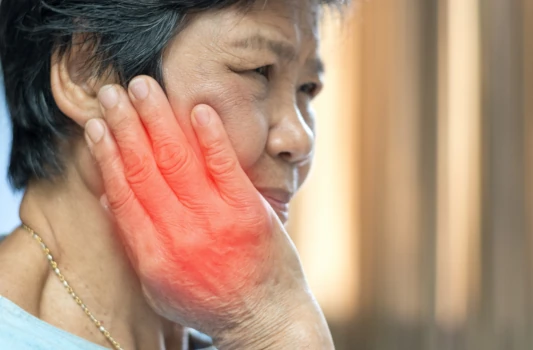What to Expect for Temporomandibular Joint Massage
Monday, March 29, 2021, 10:55 AM
Temporomandibular joint (TMJ) massage is growing in popularity as we continue to wear masks regularly and live with increased levels of stress and anxiety.
We spoke with NHPC member Deanna Hannem, owner and operator of Dinosaur Valley Massage and Wellness, about TMJ massage and what clients can expect going into a session.

What is TMJ?
According to the Canadian Dental Association, the temporomandibular joint is located on either side of the ears and connects the jawbone, or the mandible, to your skull. This is the joint that helps you do things like chew, swallow, talk and yawn.
Temporomandibular joint disorder (TMD) occurs with excessive teeth grinding or clenching, jaw injury, stress, head or neck tension, and now, repeated or prolonged use of masks.
Common symptoms of TMD include pain and tenderness, clicking or popping, grinding, or trouble opening and closing the mouth.
How Can TMJ Massage Help?
TMJ massage works the muscles around the temporomandibular joint to help relieve pain and tension. This can sometimes also include intra-oral massage.
Deanna has helped her clients with TMDs for six of her ten years working as a massage therapist.
In one case, she had a client come to her practice with consistent earaches. The client had previously seen her physician and a chiropractor on multiple occasions. She had also been through many tests and tried many medications to resolve the issue.
Deanna suggested they add TMJ massage to the client's treatment plan. After just one session incorporating TMJ treatment, the earaches subsided. They slowly resurfaced after the first treatment, so they continued with three more treatments. Now, Deanna's client has not experienced earaches in over a year.
What Can You Expect at a TMJ Massage?
A TMJ massage begins similarly to any other massage therapy treatment. You can read our blog about what to expect at your first massage therapy appointment for a better idea.
Your therapist will start by releasing the muscles in the upper back and shoulders. They will also work through your collar bone, chest, and neck to help relax all of the areas surrounding and connected to the temporomandibular joint.
There are two main methods to a TMJ massage, the first being extra-orally, or outside of the mouth. When working outside, your therapist will focus on your chewing muscles around the face.
The second method is intra-orally, or in the mouth. Prior to beginning intra-oral massage, your practitioner will put on a pair of gloves.
Deanna shared that she breaks the intra-oral massage down into sections to allow for breaks for clients to swallow. The sensation can be quite intense because we use these muscles regularly but do not often receive or self-administer massage there.
When in the mouth, she begins in between the cheek and teeth, with the muscles at the back of the mouth. Then she moves to the outside of the teeth and massages the medial pterygoid, which is the muscle that moves our jaw from side to side when we are chewing. Lastly, Deanna focuses on the area under the tongue.
After working intra-orally, your therapist may move back to the outside of your mouth and again through the surrounding muscles on the upper back, shoulders, chest, and neck to relieve any tension built up during the treatment.
A TMJ massage is often incorporated in a regular massage therapy session, but can also be done as a single treatment in a 30- to 45-minute session.
It is important to notify your therapist of any pain or discomfort throughout your treatment. If severe pain persists, contact your doctor.
How Can You Relieve TMJ Pain at Home?
You can't always get in to see your local practitioner when pain strikes. Deanna shared with us three ways to alleviate temporomandibular joint pain at home.
Method One
Using your thumb, apply pressure to the area just under your cheekbone. At the same time, gently open the jaw against the pressure. Repeat as needed.
Method Two
This method is often called "bulldog." Begin by opening the jaw and scooping your lower jaw forward. Then, close the jaw finishing with the lower teeth in front of the upper teeth.
Method Three
Drag the thumb along the edge of the jawbone under the chin in a forward or backward motion, whichever feels best for you. This will release the floor of the mouth.
TMD is a growing concern for many. If you experience TMJ pain or discomfort, you should consult your dentist or doctor for the best treatment plan.

